Fix: Bluetooth Paired but Not Connected
Many users come across a phenomenon where their Bluetooth device is paired with the computer but is not connected. The computer shows a status of “Paired”, the Bluetooth device shows a status that is connected to some device, but, in reality, you cannot access the Bluetooth device from your computer.

Configuring Bluetooth is a technical process and this problem complicates things even further. This problem is notable when you are using more than 1 Bluetooth device with your computer. We have listed down a number of different workarounds to solve your issue. Start with the first one and work your way down.
Solution 1: Connecting to the Paired Device
Sometimes you have to connect to an already paired Bluetooth device. This issue particularly arises if you use more than one Bluetooth device or when you connect the Bluetooth device. We will simply use the action center to select and connect to the device.
- Press the Windows + A to launch the action center.
- Press on the “Connect” button present at the near bottom of the window. It will appear as a button.
- Now select your device from the list and check if the device is performing as required.

Solution 2: Running Windows Store Troubleshooter
It is worth a shot running the Windows Store troubleshooter. Windows has an inbuilt collection of troubleshooters meant to troubleshoot problems in various categories. They will automatically detect and fix the problems (if any). We can try running the troubleshooter and check if it detects any problems and fixes them.
- Press Windows + R, type “control panel” in the dialogue box and press Enter.
- Type “troubleshoot” in the search bar of the control panel at the top right side of the window.

- Select “Troubleshooting” heading from the list of results returned.
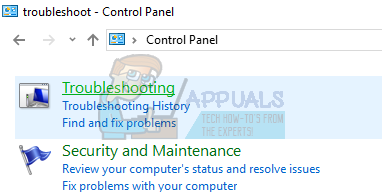
- Once in the troubleshooting menu, click “View all” present on the navigation pane at the left side of the window. Now Windows will populate all the troubleshooters available on your computer.
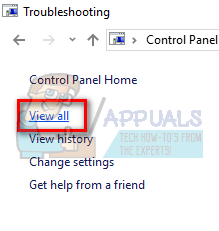
- Navigate through the options until you find “Windows Store Apps”. Click it.

- Check the option “Apply repairs automatically”. This option will ensure that you find maximum problems and the repairs are applied fast as well.
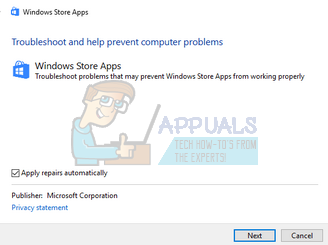
- Follow the on-screen instructions and wait for the troubleshooting to complete.
If this troubleshooting doesn’t fix your problem, we can try running the “Background Intelligent Transfer Service” troubleshooter. There were many reports from users who said that this troubleshooter fixed their problem instantly.
- Select “Background Intelligent Transfer Service” from the list of troubleshooters available.
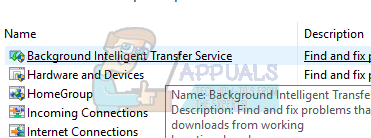
- Click on “Apply repairs automatically”. Now click “Next” and follow the on-screen instructions to complete.
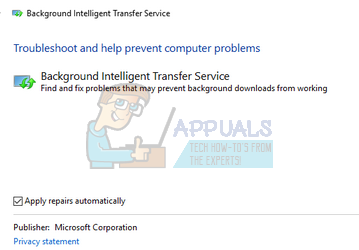
- After the troubleshooting is complete, disconnect your Bluetooth device completely. Now re-pair it and try connecting to it again. Hopefully, the problem will be solved.
Solution 3: Setting as Default Device (For Audio Bluetooth Devices)
If you are using Bluetooth speakers or headphones, we can try setting them as default devices and see if this brings any change to the situation. By setting them as default, your computer will primarily use them for output/input device. If this doesn’t work, you can always revert the changes using the same method.
- Right-click on the speaker icon on your taskbar and select “Playback devices”.

- Right-click on “[Your Bluetooth Default Speakers]” and select “Set as Default Device”. Press OK to implement changes and exit.
- Now try running any sound and check if this solved the problem.
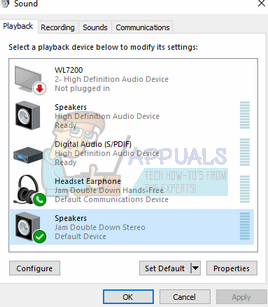
Solution 4: Restarting Bluetooth Service
Before we uninstall the drivers of your Bluetooth hardware, we can try restarting the service and setting its startup type as automatic. It is actually the Bluetooth service which is responsible for running the Bluetooth drivers installed on your computer. By restarting the service, we will reset every configuration. Furthermore, setting the startup type as “Automatic” will make sure that the Bluetooth service starts up without any intervention.
- Press Windows + R, type “services.msc” and press Enter.
- Once in the services tab, navigate through all the list until you find “Bluetooth Handsfree Service”. Right-click on it and select “Restart”.
- After restarting, right-click it again and click “Properties”. Now click on “Startup type” and set the value as “Automatic”. Press Apply to save changes and exit.
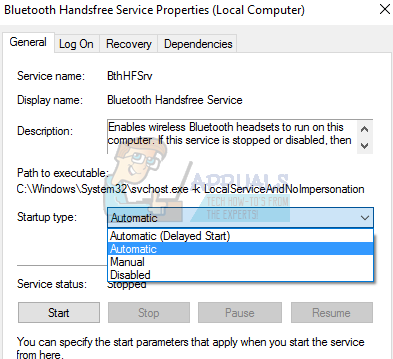
- Navigate back to the list of services and perform the exact same tasks on the service “Bluetooth Support Service”. Press Apply to save changes and exit.
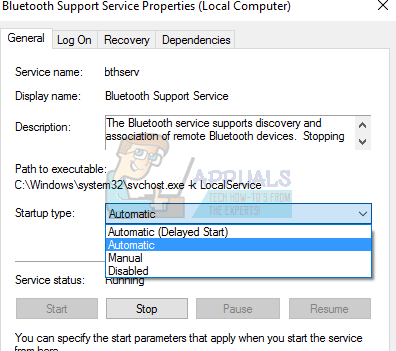
- Restart your computer and check if the problem at hand got solved.
Solution 5: Installing Default Drivers
If all the above solutions don’t work, we can try installing the default drivers on your hardware. We can do this by uninstalling the device and then checking for hardware using the device manager.
- Press Windows + R, type “devmgmt.msc” in the dialogue box and press Enter.
- Once in the device manager, expand the category of “Bluetooth”. Your Bluetooth hardware will be listed here. Right-click on it and select “Uninstall”.
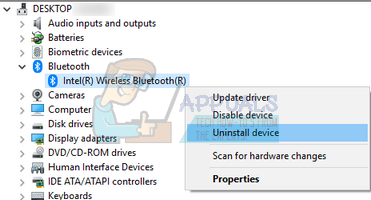
- The Bluetooth category will completely vanish from the device manager. This means that the device was successfully uninstalled.
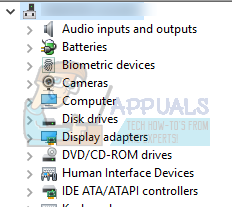
- Right-click on any empty space and select “Scan for hardware changes”. Your computer will now scan the all the hardware connected. After it comes across the Bluetooth hardware, it will automatically install the default drivers.
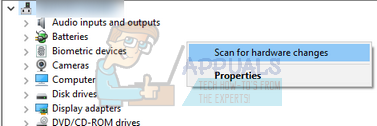
- Open the Bluetooth category again and check if the driver was successfully installed.
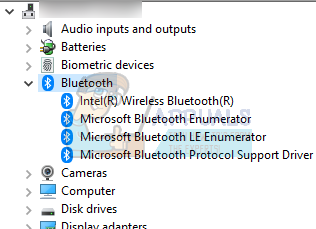
- Now try connecting your Bluetooth device again after restarting your computer. Hopefully, the problem will be fixed.
Note: You should also check if the device is enabled. Right-click on the device and select “Enable device”.
Solution 6: Updating Drivers
If installing the default Bluetooth drivers don’t work for you, you should download the latest drivers available at your manufacturer’s website to an accessible location. Make sure that you correctly identify the driver suited to your hardware and install it as mentioned below.
- Press Windows + R, type “devmgmt.msc” in the dialogue box and press Enter.
- Once in the Device Manager, expand the category of “Bluetooth” and locate your hardware.
- Right-click on the adapter and select “Update Driver Software…”.
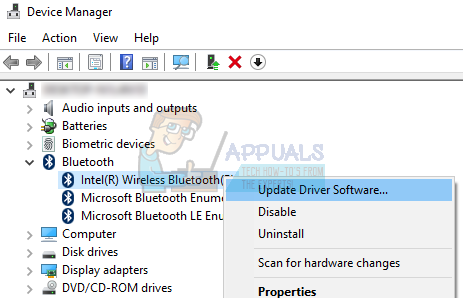
- Select the second option “Browse my computer for driver software” and navigate to the driver you downloaded.

- After installing the required driver, reboot your computer. Completely un-pair your device and pair it again. Now check if the problem at hand got solved.
Note: If all the above solutions don’t work, you should make sure that Windows is not assuming that your Bluetooth device has a screen attached to it. You should head over to [Control Panel\Hardware and Sound\Devices and Printers]. The next part is very inconsistent; double-click on your device and select “headset type” and check the line “My hands-free device does not have a display”. Press Apply and hopefully the problem will go away. You may have to double-click a number of times before the popup shows up.